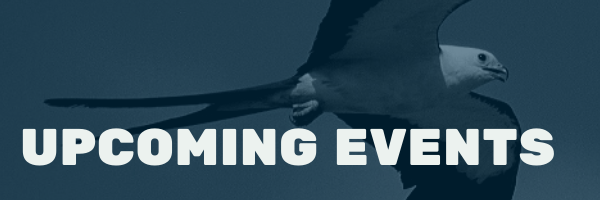
BirdCast maps predict migration intensity to help you plan your upcoming birding trips.
BirdCast
Late summer in Florida can be a dull time for birders, with breeding season wrapped up and stifling temperatures slowing down birds and birders alike. Luckily, fall migration is just around the corner!
This is also a time of year when many of us are frequently checking weather forecasts and radar to track major weather events as we ramp up into the peak of hurricane season. Did you know that the same technology used to track and forecast storms can help us understand and predict bird migration patterns?
Radar is short for “radio detection and ranging,” and works by emitting an electromagnetic pulse from a radar unit, which bounces off of a target, and then bounces back to the unit. Most of us are familiar with weather radar maps but it comes as a surprise to many that precipitation isn’t the only thing that can be picked up. Detectable targets include everything from aircraft to smoke particles to – yes – birds! Technological advancements in radar devices and computing power have made it easier to distinguish bird activity from that of other targets, and to quickly process that information so it can actually be used to predict migratory activity. Which is perfect for figuring out when it’s worthwhile to get up at the crack of dawn to check out your favorite migratory hotspots.
If this all sounds confusing, not to worry – scientists at the Cornell Lab of Ornithology use historical radar data on bird migration along with weather forecasts to predict upcoming activity, so you don’t have to. Maps for three upcoming days can be found at BirdCast.info, and are helpfully color-coded. Just look for the brightest spots on the map to know where you’re most likely to see high levels of migrant activity. They also create live radar maps of real-time activity. You can think of the difference between the two like checking the weather report for the week versus looking at live weather radar.
While BirdCast is a great tool for birders looking to maximize their species counts in spring and fall, this data also has important implications for conservation. Migration is a vulnerable time for many species. Traveling between breeding and wintering grounds can be exhausting on its own, and additional hazards such as lighted windows or wind turbines can spell even more trouble. Being able to accurately predict major migration waves can help us plan to reduce these dangers when flyways are busy.
You can learn more about how to use the BirdCast forecast tools on Cornell’s All About Birds site and, if you are so inclined, learn more about the nuts and bolts of the tools on the BirdCast site. 
Tarkiln Bayou Preserve State Park has 7.5 miles of trails, including an ADA accessible path and boardwalk overlooking the scenic bayou. FDEP Photo
Trail Site of the Month: Tarkiln Bayou Preserve State Park
Just a half hour from downtown Pensacola, Tarkiln Bayou Preserve State Park offers an off-the-beaten-track experience for birders, hikers and rare-plant enthusiasts. The beautiful preserve is made up of over 4,000 acres of wet prairie and coastal bayou, with miles of trail to explore. The half mile ADA accessible Tarkiln Bayou Trail leads through prairie, cypress and titi forest, ending at a scenic observation area over the Bayou itself. The longer 6.5-mile Perdido Bay Trail loops through upland areas and across seepage streams, eventually leading to the bayshore beach. Amenities are limited and there is no potable water available at the park. Remember to bring plenty of water and sun protection if you are planning a hike.
Late summer is a quiet time for birds but with fall migration just around the corner, the park will be an excellent place to search for migrants – 13 species of wood warbler have been reported on eBird, including Hooded and Magnolia Warblers. Keen-eyed visitors to the park will also find plenty of interesting plants, including orchids, sundews and pitcher plants. The park is home to some of the largest stands of the endangered white-topped pitcher plant found in the state of Florida.
If you need to cool down after a hike at the park in this late summer weather, there are two other state parks within a 15-minute drive where you can view more wildlife while taking a refreshing dip in the water. Perdido Key State Park lies on sugar sands of the Gulf coast and is a popular destination for swimmers, sunbathers and anglers. Big Lagoon State Park, on the Intracoastal Waterway, offers opportunities for swimming, boating and hiking along five miles of nature trails along the shore and through the coastal forest. 
Check out the events page of our website for more to do across the state!
Do you know about any other bird- or wildlife-related events going on in Florida? Help spread the word by letting us know! Send in the times, dates, locations and contacts to WildlifeViewing@MyFWC.com for posting on the Great Florida Birding and Wildlife Trail website.
Events must be related to birds or other wildlife and must be open to the public. Examples include interpretive programming, summer camps and family programs.
| 
No comments:
Post a Comment